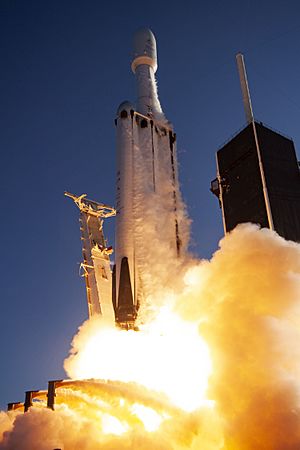Falcon Heavy facts for kids

SpaceX's Falcon Heavy rocket lifts off from Kennedy Space Center LC-39A with the Arabsat-6A satellite (April 2019).
|
|
| Function | Orbital heavy-lift launch vehicle |
|---|---|
| Manufacturer | SpaceX |
| Country of origin | United States |
| Cost per launch |
|
| Size | |
| Height | 70 m (230 ft) |
| Diameter | 3.66 m (12.0 ft) |
| Width | 12.2 m (40 ft) |
| Mass | 1,420,788 kg (3,132,301 lb) |
| Stages | 2+ |
| Capacity | |
| Payload to LEO (28.5°) | 63,800 kg (140,700 lb) |
| Payload to GTO (27°) | 26,700 kg (58,900 lb) |
| Payload to Mars | 16,800 kg (37,000 lb) |
| Payload to Pluto | 3,500 kg (7,700 lb) |
| Associated rockets | |
| Family | Falcon 9 |
| Comparable | |
| Launch history | |
| Status | Active |
| Launch sites | |
| Total launches | 3 |
| Successes | 3 |
| Landings | 7 cores landed / 9 attempted |
| First flight | February 6, 2018 |
| Boosters | |
| No. boosters | 2 |
| Engines | 9 Merlin 1D per booster |
| Thrust | Sea level: 7.6 MN (1,700,000 lbf) (each) Vacuum: 8.2 MN (1,800,000 lbf) (each) |
| Total thrust | Sea level: 15.2 MN (3,400,000 lbf) Vacuum: 16.4 MN (3,700,000 lbf) |
| Fuel | Subcooled LOX / Chilled RP-1 |
| First stage | |
| Engines | 9 Merlin 1D |
| Thrust | Sea level: 7.6 MN (1,700,000 lbf) Vacuum: 8.2 MN (1,800,000 lbf) |
| Fuel | Subcooled LOX / Chilled RP-1 |
| Second stage | |
| Engines | 1 Merlin 1D Vacuum |
| Thrust | 934 kN (210,000 lbf) |
| Fuel | LOX / RP-1 |
The Falcon Heavy is a giant rocket built by SpaceX. It's designed to carry very heavy things into space. This rocket is special because parts of it can be reused, which helps save money.
The Falcon Heavy is based on the Falcon 9 rocket, but it's much bigger and stronger. It can lift a huge amount of weight, about 63,800 kilograms (that's like 10 elephants!) into low Earth orbit. This makes it one of the most powerful rockets ever built. Only a few rockets in history, like the Saturn V and Energia, could lift more. As of 2020, it's the most powerful rocket flying!
Contents
First Flights and What It Carries
The Falcon Heavy had its first flight on February 6, 2018. It was a test flight, and it carried something really cool: a Tesla Roadster sports car! This car belongs to Elon Musk, who started SpaceX. The car was sent into a path around the Sun.
The first time the Falcon Heavy carried a real satellite was on April 11, 2019. It launched a satellite for a company called Arabsat. This mission was a big success.
Future Plans for Falcon Heavy
The Falcon Heavy was designed to be able to carry people into space. It could even go to places like the Moon or Mars one day! However, right now, it's not approved to carry astronauts. Instead, it's used to launch very large satellites or special space probes that explore our solar system.
How Falcon Heavy Works
The Falcon Heavy is made up of three main parts, or "cores," at the bottom. Each of these cores is like a Falcon 9 rocket. They all have nine powerful Merlin 1D engines. This means the Falcon Heavy has a total of 27 engines firing at launch!
After the main engines push the rocket high into the sky, the two side boosters separate. These boosters then fly back to Earth and land upright, ready to be used again. The central core continues to push the rocket higher before it also separates and tries to land.
Then, the second stage of the rocket takes over. It has one special engine called a Merlin 1D Vacuum engine. This engine works best in the emptiness of space. It pushes the payload (like a satellite or spacecraft) to its final destination.
Related pages
Images for kids
-
Falcon Heavy on pad LC-39A
-
Falcon Heavy reusable side boosters land in unison at Cape Canaveral Landing Zones 1 and 2 following test flight on 6 February 2018.
See also
 In Spanish: Falcon Heavy para niños
In Spanish: Falcon Heavy para niños








